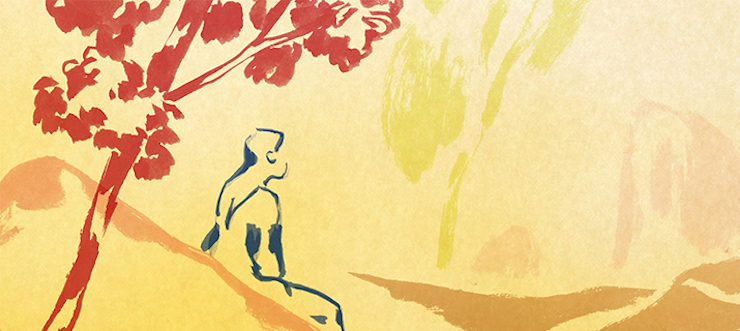“You wanted to be rich. How could you be in peace?”
The fairy tale “The Girl Without Hands,” first published by Jacob and Wilhelm Grimm in the 1812 Children’s and Household Tales, and revised in subsequent editions, has never been a particular favorite of filmmakers for a long list of reasons, including, but not limited to, its disturbing subject matter, its split storyline (the second half of the story almost seems to be discussing different characters), its religious themes, and the perceived difficulties of portraying a character losing both hands. It would, I think, make for a great live action horror flick—but that’s not the way Hollywood has seen the story, at least so far.
None of this, however, stopped French animator Sébastian Laudenbach from using it as the subject of his first film, which debuted at the 2016 Cannes Film Festival and later at the Annecy International Animated Film Festival, where it lost two awards to My Life as a Zucchini, but picked up the Jury Award—just enough to earn it an extremely limited release in the United States in 2017.
The win was entirely deserved: however questionable the subject matter, the animation is, well, astonishing.
Sébastian Laudenbach not only wrote and directed, but almost single handedly animated the entire 76 minute film, with only three other compositing artists (presumably focused on the special effects and lighting) credited for the film. If he largely handled the art and writing himself, he did turn the voice and sound work over to other artists—including his father, Philippe Laudenbach, a distinguished French actor who voices the Devil. (Don’t be too horrified by this casting choice or try to draw too much meaning into it—I mean, yeah, Devil, but on the other hand, the Devil is far from the worst parent in the film.) But the film remains largely the work of the younger Laudenbach.
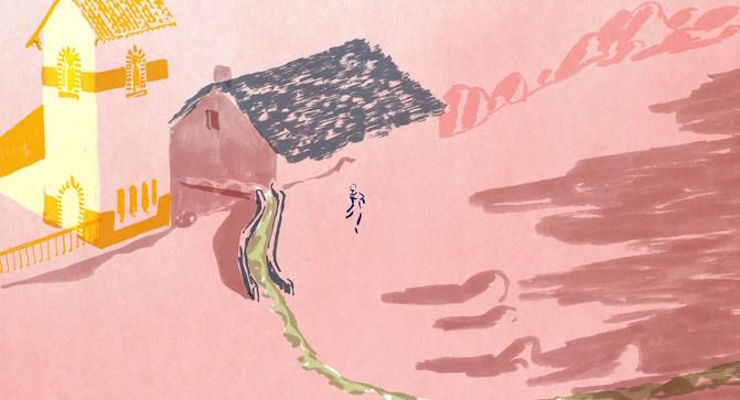
Laudenbach spent a full year painting individual images on paper with watercolor and ink, starting with the opening credits and going straight through to the end. The images vary: Some frames are fully, brilliantly painted, while others are no more than ink sketches, or only partly colored and drawn. In some moments and scenes, we see characters and their faces; at other times only splotches of colors, in vaguely human form. The transitional frames, especially, are often half drawn and colored, letting characters flicker in and out, or seem to fade into houses, water, trees and mountains, before springing free again. A few scenes work with layers of drawings, creating something similar to a multiplane camera effect, with its illusions of depths. The overall result is sometimes ghostly, sometimes abstract, almost always eerie—and nearly always beautiful.
This is apparent right from those animated opening credits, which start in black and white, depicting a simple waterfall, before leading us to a watermill, home of a miller, his wife, and very soon, a new baby—and an apple tree, which forms a play area for the girl as she grows up and learns to climb trees. The apple tree shifts colors and shapes, sometimes almost looking like a girl itself, sometimes looking a little like a house.
Apart from the apple tree, things are not going well with the miller: the water has stopped running, and he and his family have nothing to eat besides apples. That is, until he hears a pig grunting in the forest—and tries to kill it, only to be stopped by a mysterious green figure who promises to make him rich if—if—the miller pledges to give him what’s behind the mill. The miller assumes this is the apple tree.
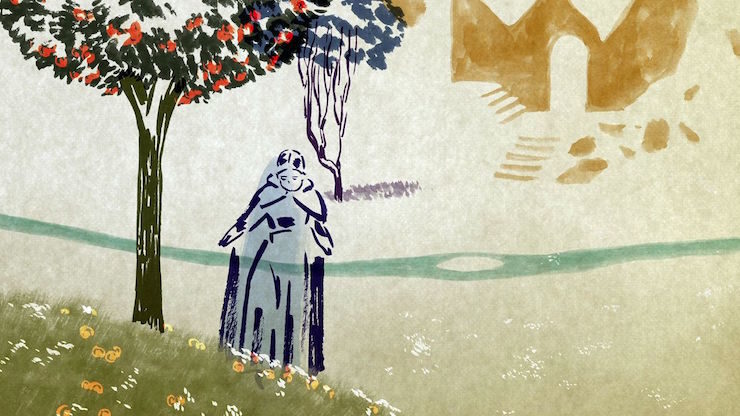
At this point I just want to note that (a) dangerous assumption there, miller, (b) and even assuming your assumption is correct, talk about one bad bargain. The apple tree at least produces apples. This green figure? Keeps flickering in and out, sounds dangerous, and just stopped you from killing a pig for food. Stay with the income and food you know, is what I’m saying. Plus, apples are very good for you. To his slight credit, the miller does point out that without the apples, he’ll have no food. To his definite detriment, he agrees with the counter argument made by the green figure: “Why live on apples if you are rich?” in our first clue that the green figure has never eaten a Honeycrisp apple.
A great gust of wind strikes—and now, the water near the mill is not just water, but gold.
Which would be wonderful, except that the miller’s daughter was resting in the apple tree during that entire bargain. This is, after all, a fairy tale about a girl without hands, and in this film, a girl who loses even more than that.
Sébastian Laudenbach largely sticks to the main outlines of the original Grimm tale, which means that most of the film focuses on the second, longer half of the tale—that is, what happened to the girl after the loss of her hands. He makes quite a few tweaks to the story—the angels of the original tale are changed to a river goddess of some sort, which doesn’t entirely fit all of the religious imagery, or, for that matter, entirely fit with the devil, for instance. A gardener, a very minor character in the original tale, is elevated to a major character here, standing in for various servants and also the elderly queen. The ending, too, is slightly tweaked.
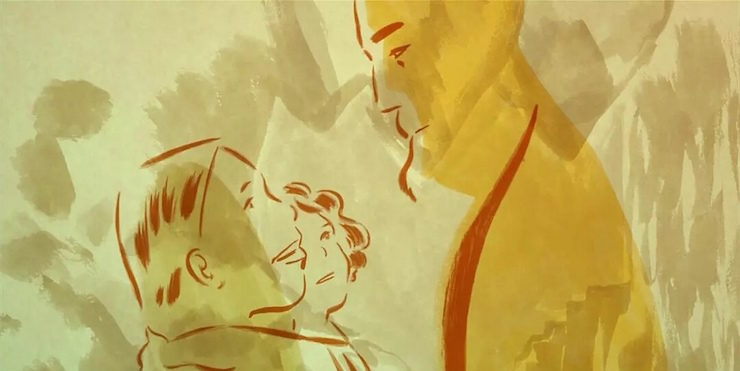
Some of those choices create a few issues in the tale—for instance, it’s kinda mindboggling to see the girl, technically a princess or queen at this point, giving birth without anyone other than the gardener around, especially since earlier scenes at least suggested, through colors and images, that other servants live in the castle, and the girl was introduced to a rather large group of people. In another scene, the baby is left alone with only the girl, and not a single servant or family member to help—something that certainly happens in real life often enough, but not, perhaps, quite as often to royalty.
And intentionally or not, the end result is that very few of the characters, including the main protagonists, come across as particularly likable—especially, and perhaps most regrettably, the prince. This is partly, of course, thanks to the way they are drawn, and the way Laudenbach often depicts them more as abstract images than people. But it’s also partly the dialogue, and the way that the plot jolts between lingering too long on certain scenes (the girl’s journey from the mill, for instance) and rushing through other moments (largely the moment when the protagonists fall in love—even by fairy tale standards, or even animated fairy tale standards, this is rushed and unconvincing).
But the strength of this film is not in the plot or the characters—though, as a sidenote, the voice work seems fairly good, particularly that of Philippe Laudenbach, who generates real menace and evil in his comparatively limited lines as the devil. It’s the artistry of the images: the way that the apple tree often suggests a figure of a woman cradling a child, for instance, and the shifting colors used for its leaves, or the abstract beauty of the girl’s climb through mountains, as she flickers in and out, or the way the entrance to the palace manages to suggest labyrinths and darkness and dreams. Or the way the black pig keeps coming in and out of the tale, reminding us—if not always the protagonists—that the Devil is never very far.
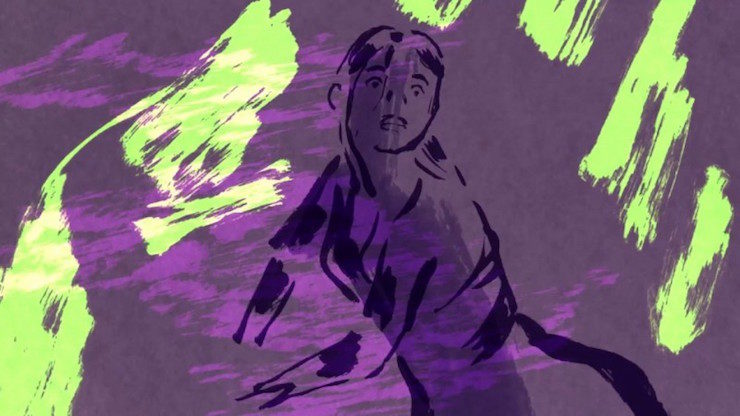
Or the way that the animation style forces ambiguity in certain scenes—most notably, in the amputation scene, where the audience cannot see the miller’s expression as he raises his axe, since this is one of those half-drawn frames. Only afterwards, in a full painted frame, do we see his full expression, and the Devil’s smile, before both start to flicker in and out again.
A film like this, not surprisingly, also has a disability focus. This includes elements like a nice moment where the prince admits he can’t read a letter—until the gardener gives him glasses. Other scenes show the girl digging holes in the ground and planting beans with her mouth and stump—a sequence showcasing both the importance of assistive devices and the reality that disability does not always mean inability. This is a lesson the girl herself has to learn—and does so after throwing away the golden hands given to her by the prince, who, I might add, created these without consulting her to find out what she needed—but it’s a powerful, pro-disability message all the same. Her father has removed her hands; the devil—and the pig—have betrayed her to her husband; the gardener has sent her out alone, but she is not destroyed.
It does, of course, help that she has a magic river.
All this said, I hesitate to recommend this film to fairy tale lovers. Oh, it’s beautiful, yes, but it’s also slow, and not for the first time, I found myself understanding just why Disney, and even Warner Bros in its cartoon shorts, decided to add additional characters to their films.
But I can unequivocally recommend this film to animation buffs, especially those missing the days of innovative hand drawn art—not completely vanished, as this film shows, but certainly overshadowed by the blockbuster computer animated films from Disney, Pixar, Dreamworks and Fox Animation.
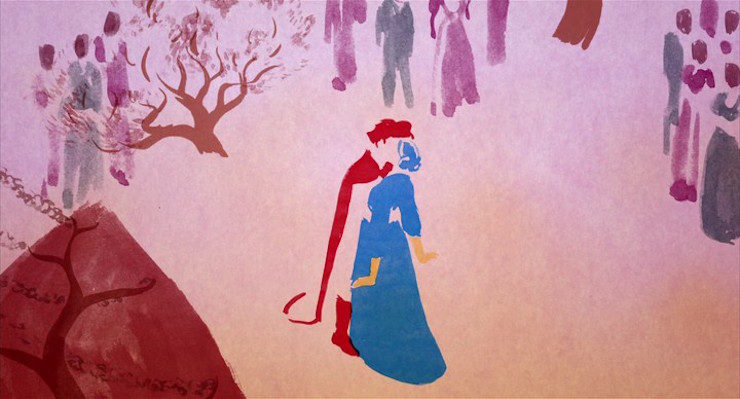
With one added note: although this is an animated film, it’s decidedly not for younger children. It includes nudity, violence, implied and direct violence done to nude women, one brief implication of oral sex, followed by implied sex interspersed with images of soldiers killing each other in, how to put this, very phallic ways, and a horrific moment where a character is torn apart by dogs as the Devil—looking remarkably monk-like—cavorts in the background. Teenagers should be fine.
Older viewers should also be warned that the song that plays with the closing credits is somewhat jarring, and that a few of the above mentioned moments may also disturb them.
With 20 reviews, La jeune fille sans mains/Girl Without Hands currently holds a 100% approval rating on RottenTomatoes. Despite this, the film received virtually no attention in the U.S. during its extremely brief theatrical release, earning a grand total of $21,727 in several weeks of release. (To be entirely fair, it was only on three to four screens on any given day during this period.) It made equally little splash in France, where it earned $99,233 in two weeks before getting pulled from theatres. The combined total was presumably barely enough to cover basic production expenses, if even that. If you are interested in throwing money in its direction, it’s currently available on Bluray/DVD and on Amazon, iTunes and Google Play streaming services in the U.S., and on other streaming services worldwide.
Mari Ness lives in central Florida.










